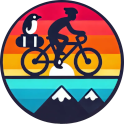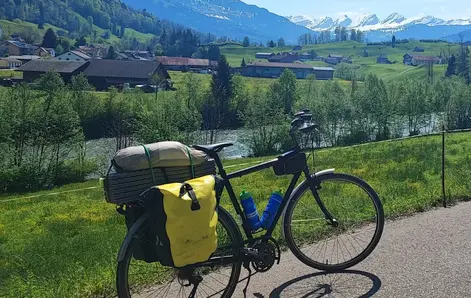Although I’m someone who tends to leave a lot to improvisation, I’m not so carefree as to skip testing the gear I’ll take on the BIG JOURNEY. Since we* have had pretty much everything we consider necessary for a while now, we’ve been able to do a few short trips near where we live to see if we are missing anything or carrying too much. And as we live near many borders, those short adventures took us to a couple of countries. Here’s how our recent rides through Austria, Germany, Liechtenstein, and Switzerland went!
*I will be bikepacking with my girlfriend, Rebecca, who also took part in the first two trips I am going to talk about.
Content:
- 1. First Test: Lake Walen and Toggenburg
- 2. Allgäu: Better on a Bike
- 3. Testing the Saddle on Long Rides
- 4. Steel on Steep Climbs
1. First Test: Lake Walen and Toggenburg
The first round (early Spring 2024) to test the equipment was also an excuse to ride along the beautiful Lake Walen (in German, Walensee) and the breathtaking Churfirsten mountain range. I have been on top of some of those peaks –even in the Winter–, and the view from them is always breathtaking. But this time I wanted to encircle them.
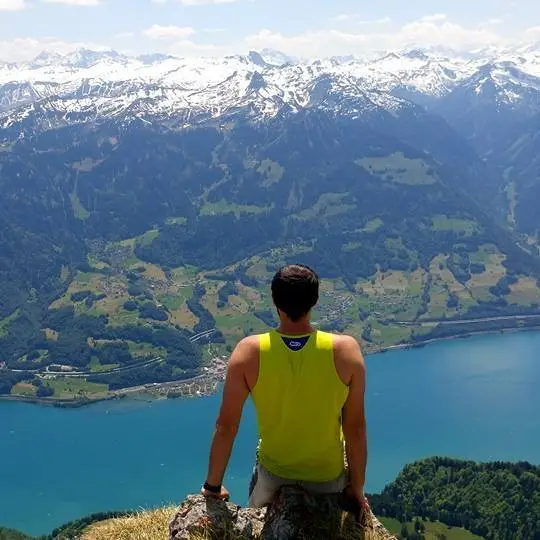
After cycling the 25 km that separate me from Liechtenstein, we crossed this tiny country via the paved bike path that runs alongside the Rhine. Traveling it from north to south is less than 30 km with no elevation gain, so in about two hours, you’re already heading back out toward Switzerland in the direction of Sargans. This time, we only passed through without stopping, but I’ll share more about it later.
From Sargans, and still on bike paths so far, we reached Lake Walen. The day had been quite cloudy, but little by little, the sky began to clear. The Churfirsten range came into view, and everything was going perfectly.
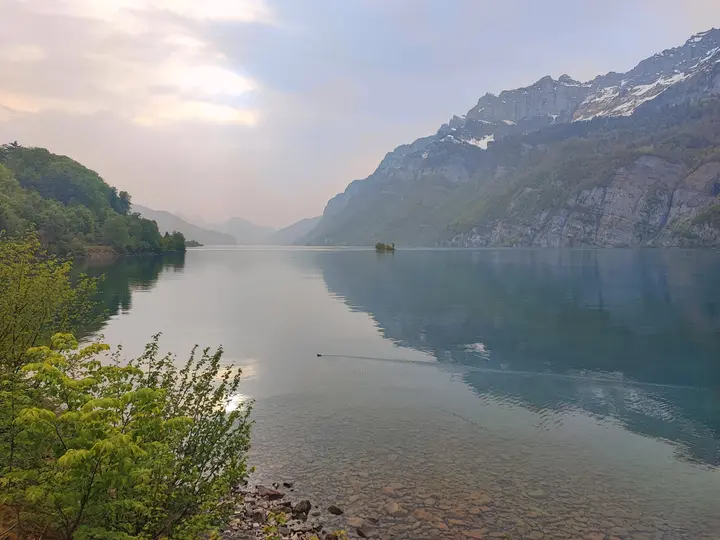
Things started to go a bit downhill when we discovered that the bike path running along the lake was closed for construction, forcing us to ride on a parallel road with heavy traffic, which somewhat broke the magic. Fortunately, after just over an hour, we managed to return to the section of the bike path that wasn’t under construction. By then, it was time to start looking for a place to sleep i.e., a good spot to camp.
Although it depends on each Canton and municipality, wild camping in Switzerland is only allowed under certain circumstances: one single night, in the mountains above the tree line, outside protected areas, and never in groups. Camping near Lake Walen is only permitted in designated campsites in Walenstadt, Murg, and Gäsi. I’m completely against banning responsible camping in non-protected areas, and where I camp usually ends up cleaner when I leave than when I arrived, as I pick up the trash I find nearby. You might think I always wild camp, and if I did, it would be in quiet and secluded places where I would have never had any issues 😉
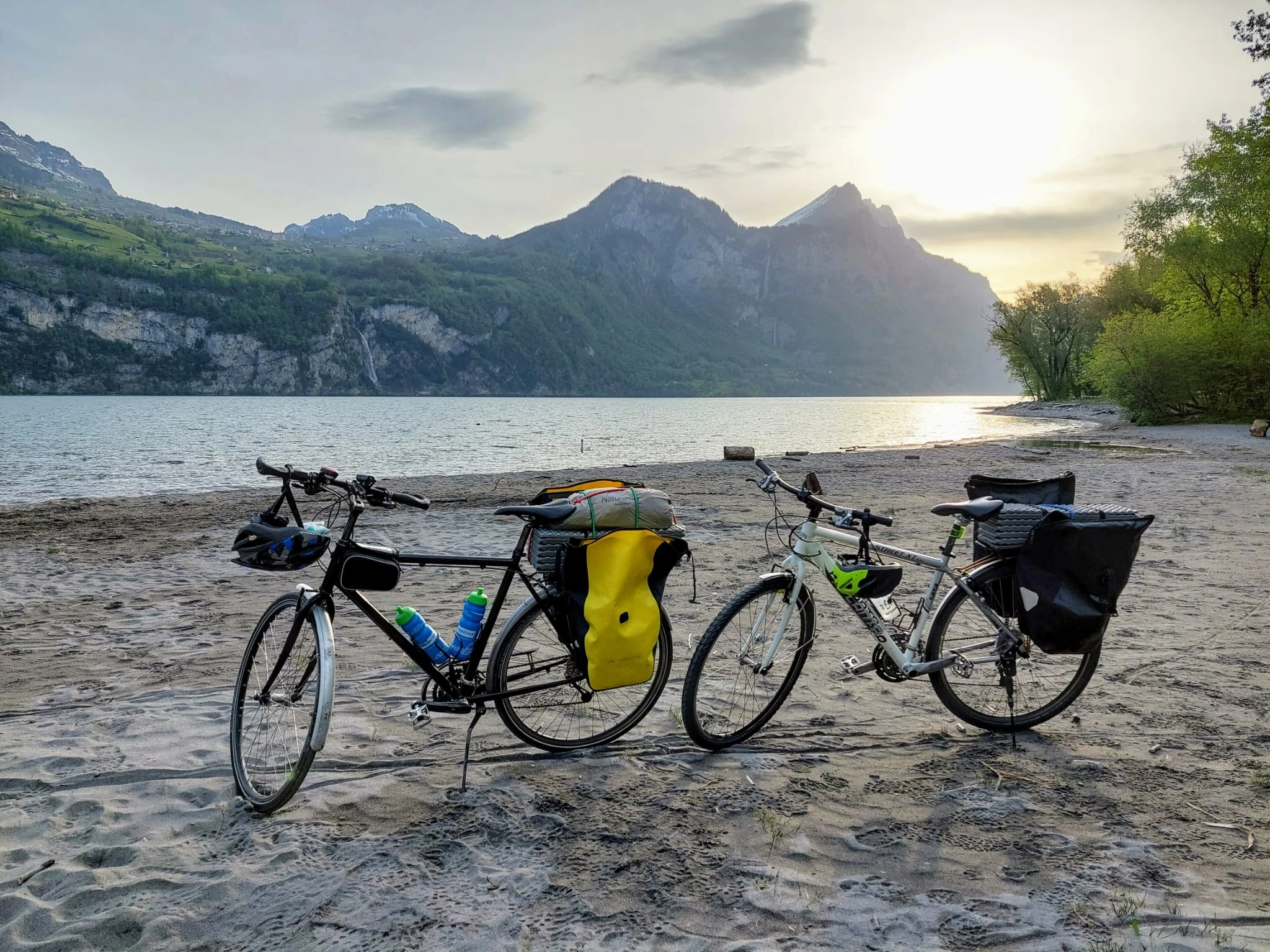
The next morning, the clouds had almost completely disappeared, and we continued without setbacks toward the Toggenburg region. This day had a lot more elevation gain than the previous one, but without steep gradients, making it manageable for anyone used to cycling. Toggenburg, and especially the surrounding mountains like the Alpstein, is a paradise for climbing and hiking. If you ever get the chance, don’t hesitate to visit!
After crossing the valley from end to end, all that was left was to descend back toward the Rhine Valley and home. In theory, the gear was fine, but it still needed a bit more testing: we had brought a gas stove instead of the gasoline one we planned to use for the trip, we hadn’t filtered water, and the weather had been good so far, so we still needed to ensure we were equipped for the cold. This last point wasn’t tested on a bike trip but rather on our trip to Iceland a month later, where we camped almost daily.
2. Allgäu: Better on a Bike
The second test was in the summer: a three-day loop through southern Germany, specifically in the Allgäu region. It’s a place that might seem very monotonous if you drive through it, but on a bike, it truly shines: green hills, quiet villages, little-traveled paths, and the Alps always in the background. While it’s not a physically demanding region, it’s far from flat. I’d still call this route a “pleasure trip,” but I wouldn’t tackle it on a fixie 😉
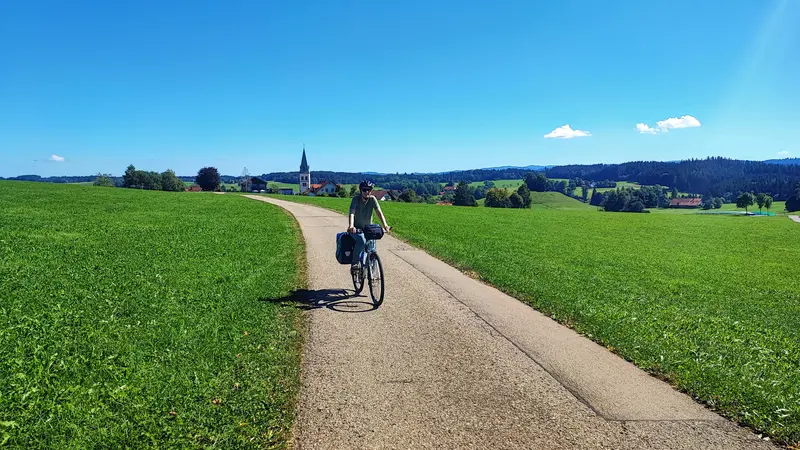
This time we had some extra equipment that we were going to take with us for our adventure: a water filter, a gasoline stove, and in my case, a little stick to hang flags. I could tell you that they add visibility and therefore security on the road, but the truth is that they are a good icebreaker: people see where you are from and where your trip started, and it catches more attention than just a fully-packed bike.
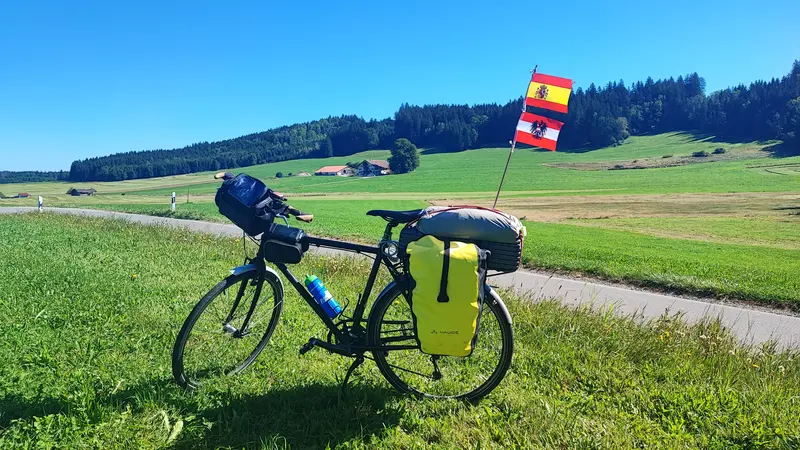
After crossing the border between Austria and Germany along the shores of Lake Constance (Bodensee in German), we headed inland. As soon as you leave Lake Constance, where the bustle of bikes and pedestrians is often overwhelming, tranquility takes center stage: few people outside the urban areas and little traffic by German standards.
Before reaching Isny, we decided to find a quiet spot to spend the night, but not before testing out the gasoline stove (loaded with white gas). It’s a bit more complex than the gas stove and initially feels a little intimidating, but it’s much more powerful and boils water in the blink of an eye!
We thought that staying away from the bushes and trees would be a good idea to have more space around the tent, but I have to admit that it wasn’t. The next morning, everything we had left outside was soaked with dew, and the outer layer of the tent was covered in droplets, just like everything else around us… except under the trees! We quickly realized what to do next time to save ourselves the trouble of drying everything out.
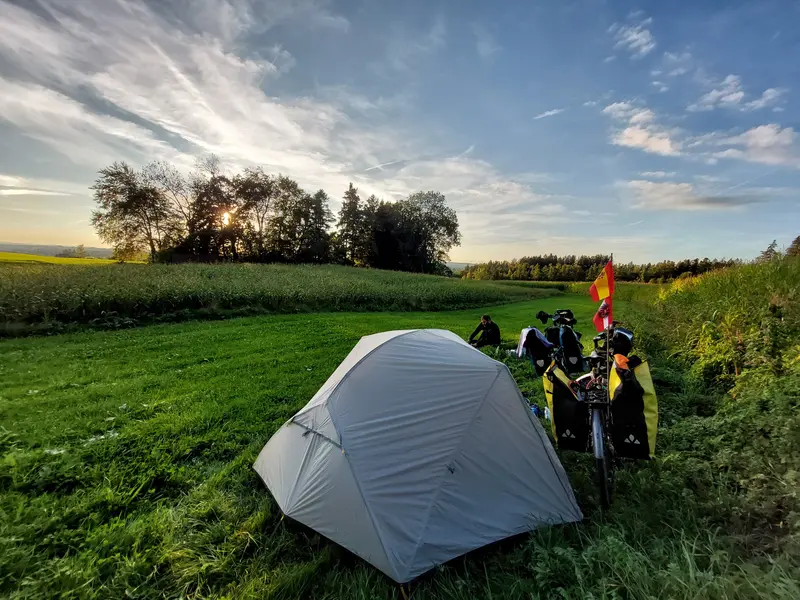
Moving on, we passed through the small and charming town of Isny before heading toward Bad Waldsee, the northernmost point of our route. Personally, I liked Isny more, even though it doesn’t have a lake-surrounded center. Still, it was a nice place to grab some ice cream and test the water filter, which in our case is a gravity-powered one. It’s not the fastest, but it can filter a lot of water at once and requires little maintenance.
A few kilometers later, we found our next hotel with a million stars. Confirmed: under a tree, everything stays much drier.
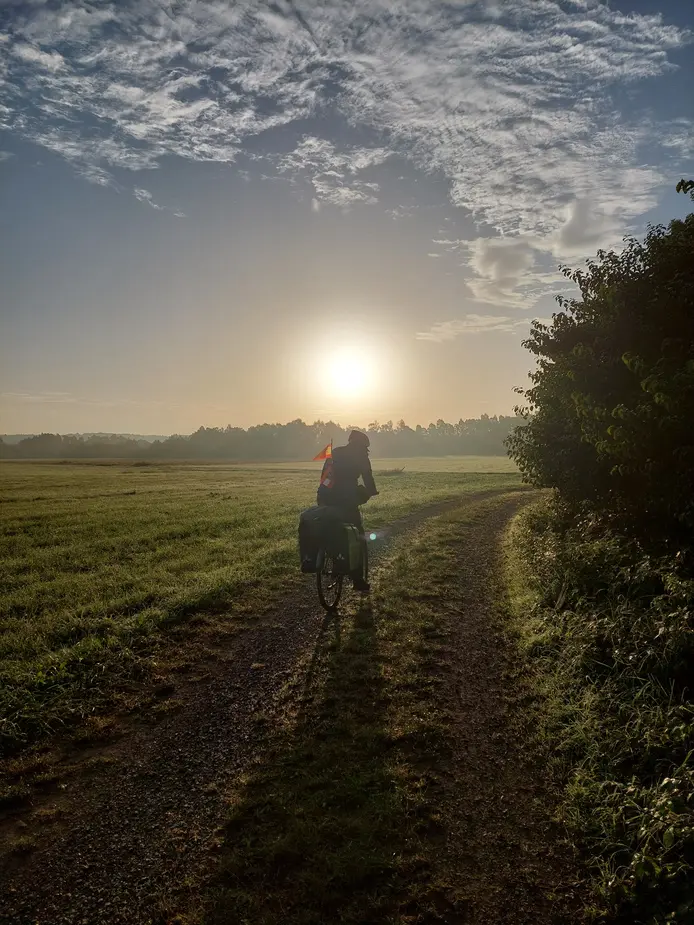
Our third and final stage first took us to Ravensburg, where we had a second breakfast of the day. This city is much larger than the others we passed through, but it has a beautiful center worth seeing, especially its many towers. From Ravensburg, with a little stop along the way to make some coffee, we headed back to Lake Constance and then home. Once again, we were happy with the gear we’re planning to take on the trip, though I did end up with a slightly sore backside!
3. Testing the Saddle on Long Rides
For the next trip, a long weekend ride to Zurich, I went solo and packed light: no tent, just a thin sleeping bag. In the end, I didn’t even use the stove, but hey, I had to put something in the panniers!
The start of the route was similar to the first one: through Liechtenstein and alongside Lake Walen, with the difference that this time the bike path was open, making the stretch by the lake much more enjoyable. I planned to cover more kilometers each day, so I continued all the way to Lake Zurich (Zürichsee), which is quite long and ends in Zurich itself. I decided to find a quiet spot by the lake around 20 km before reaching the city, and since it was warm and the place was lovely, I had a very pleasant bivouac.
In case it’s useful to you, the place is called Ürikon, and it consists of a tiny pier and an even smaller park that ends abruptly at the water with a step leading into the lake. It’s so close to the water that when I sat on the grass to read for a while, a boat passing in the distance created a tiny wave that ended up splashing me. Move your stuff one meter away to keep it dry!
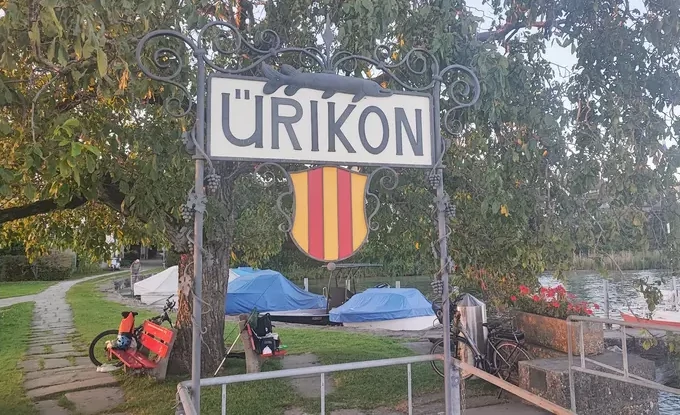
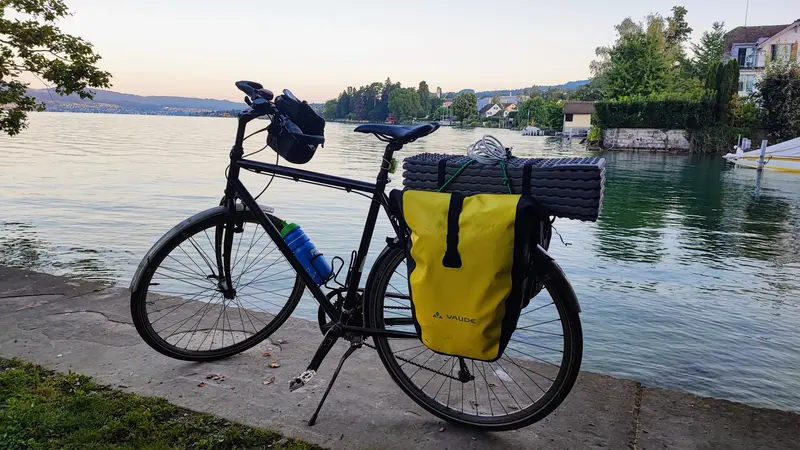
Despite the 120 kilometers from the day before, I woke up early and feeling pretty good, though my backside was starting to hurt more than it should. I took advantage of the morning to ride into Zurich and arrived there quite early. It was Sunday, so I had the city almost to myself for a little while.
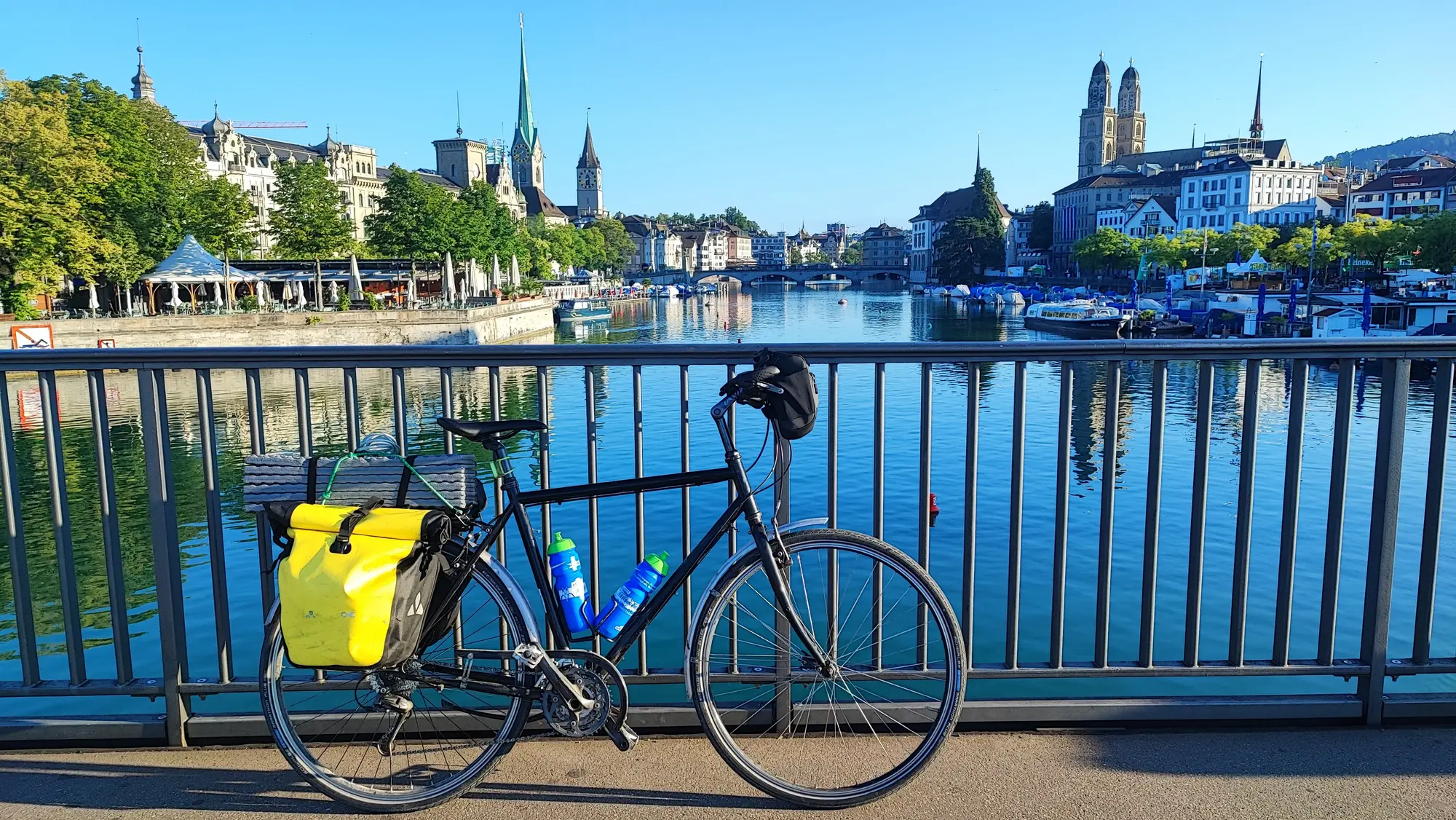
Right after leaving Zurich, I faced the only and not very demanding climb of the route, followed by a rather boring stretch until I reached Lake Constance on its Swiss side, passing through Winterthur. By this point, my backside was in agony, and I was already sure that saddle wasn’t going to make it to the big trip.
I’ve cycled along this side of the lake a couple of times, so I know it fairly well. I didn’t stop much, as there were still quite a few kilometers left to get home. Most of the riders around the lake find the German side more beautiful, but apart from the touristic towns like Meersburg or Lindau, I would say that the Swiss side is more pleasant to ride, especially because you only cycle on bike paths, and it is way less crowded.
In the end, the second stage was about 170 km, at least 100 of which were spent cursing the damn saddle 😂
This trip showed me that I would be able to cover long distances if required, especially if I got another saddle, which I did shortly after.
4. Steel on Steep Climbs
On flat sections or downhill stretches, I don’t notice much difference compared to aluminum or carbon bikes, but uphill… well, let’s just say things get interesting. That’s why I wanted to try a ride with more elevation gain, ideally in one continuous stretch.
After browsing the map for inspiration, I decided to tackle the Kunkels Pass by way of the Tamina Valley, then loop back through Chur and the St. Luzisteig Pass. It was an area I wasn’t very familiar with but seemed intriguing, so I packed up (this time nearly everything I plan to take on the trip, as the Autumn is rather chilly around here) and set off once again toward Liechtenstein/Switzerland.
By the way, even though gaining altitude when it’s already quite cold in the valley might not sound like the best idea, low fog is quite common in the Alps during autumn, particularly near Lake Constance. Often, all it takes is climbing a bit higher to break through the fog, find blue skies, and enjoy the sunlight.
On this first day, I encountered dense fog until I passed through Liechtenstein and reached Bad Ragaz, Switzerland, where the climb up the valley toward the Kunkels Pass begins. Most cyclists in the area, typically riding road bikes, take a less-traveled road toward Pfäfers. However, there’s a lesser-known alternative: the Valenserstrasse. This road, closed to cars without special permits, is even more interesting. The pavement has seen better days, and the route is steep, but it winds through a dense forest, making it especially appealing for a bikepacker like me. I have to admit, I worked up quite a sweat on the steeper sections, but I managed to reach the main road intersection without putting a foot down.
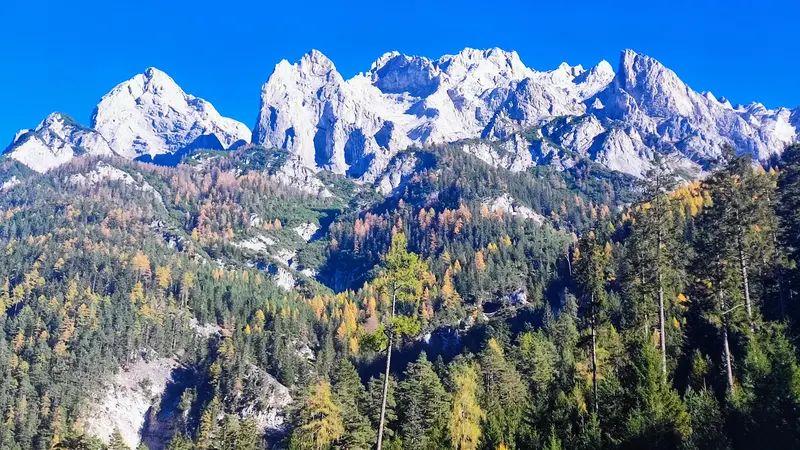
Whichever route you choose, if you’re passing through and have the time, check out the Tamina Gorge (Taminaschlucht), a stunning natural wonder carved out by the Tamina River. This time, I didn’t stop for side trips since I wasn’t sure how long the climb to the pass would take, and the sun was already setting earlier than I’d like.
Continuing along a narrow, lightly trafficked road on the other side of the valley—with plenty of road cyclists for company—the route climbs gradually and steadily until you reach a tiny village called Vättis. From there, cars disappear, and you get the feeling the summit of the pass is just around the corner. That might have been true for the numerous cyclists on professional-grade, state-of-the-art bikes overtaking me, but not so much for someone hauling their belongings on a regular bike 😅
The scenery at this point is absolutely breathtaking, with particularly striking mountains, a mix of green meadows, patches of early snow, and dense forests. After climbing for several hours from Bad Ragaz (no less than three), I finally reached the Kunkels Pass, which, ironically, was almost the only shaded spot on the entire climb due to a nearby hill. I am not going to lie, the climb was exhausting, and I was glad that from there I only had to ride down. After snapping a few photos and taking in the views, I began the descent toward Tamins, heading in the direction of Chur.
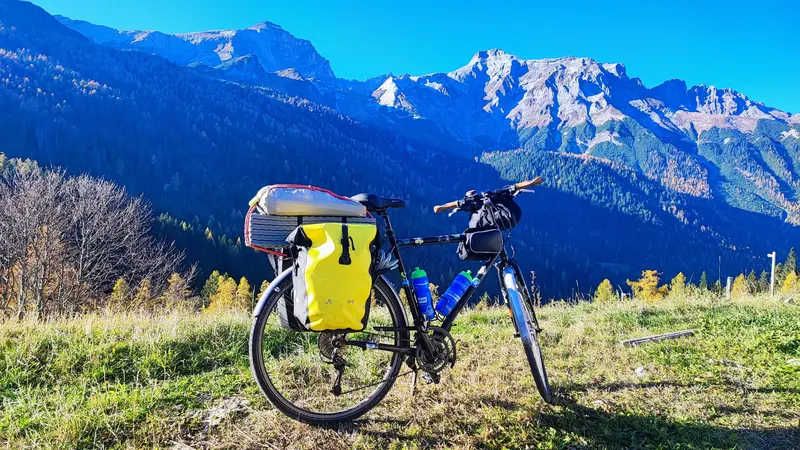
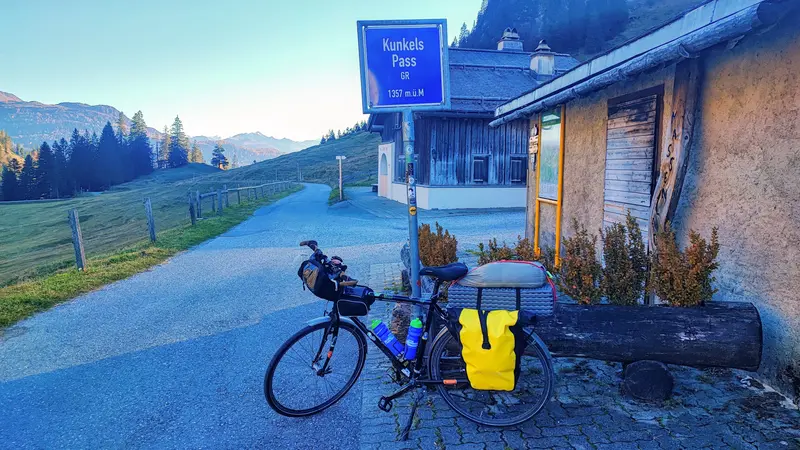
The descent on this side of the pass is less scenic than the ascent, to be honest. There are fewer road bikes here, as the surface isn’t fully paved. While manageable on a regular bike, you need to pay attention to the terrain rather than just admiring the view. Back in the lower valleys, the route follows bike paths—many unpaved—but stays close to a highway, bringing some unavoidable noise. The best approach is to keep moving quickly and head straight for Chur.
Chur’s city center is charming and worth a quick visit, especially since it’s easy to explore on a bike. By then, it was getting dark, and I didn’t plan to spend the night in the city. I continued riding to escape the bustle and find a quiet spot to spend the night.
For the second day, I had planned a route that would take me slightly off the most direct path to visit a couple of local villages, Malans and Meienfeld, before climbing to St. Luzisteig on my way back toward Liechtenstein.
The route winds through vineyards, with gentle ups and downs. The villages are very small and charming, perfect for cycling through with almost no traffic. Luckily, the valley here opens up a bit, and in autumn, the sun still reaches it relatively early, so I managed to warm up a little before tackling the climb to the St. Luzisteig “Pass.” I say “Pass” in quotation marks because the name feels a bit pretentious in this case.
Although it lies at the foot of Liechtenstein’s tallest mountains (you can hike to some of them from here), the climb itself is modest—only about 200 meters of elevation gain from Meienfeld. The road is quiet, well-maintained, and free of steep gradients. The highlight comes at the start of the descent, where the road literally passes through a small fortification on the way to Balzers. This is the first village on the Liechtenstein side, and it also boasts a picturesque castle you can ride up to on your bike.
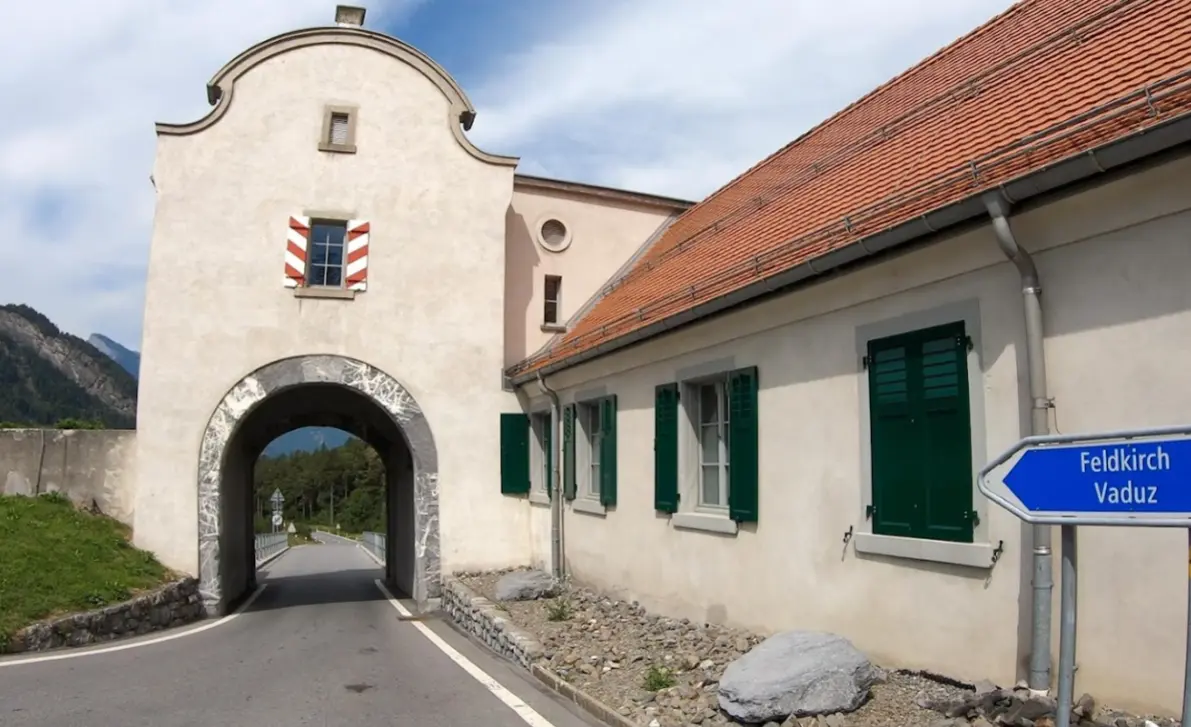
To avoid always sticking to the bike path along the Rhine, I decided to ride at the foot of the mountains, weaving through meadows and farmland and passing through Vaduz, Liechtenstein’s tiny capital. This “city” gets an outsized amount of tourism from people wanting to “check off” another country or stamp collectors visiting the local museum. The most striking feature is the prince’s castle, perched above the city. You’ll pass it if you’re heading toward the higher-altitude villages like Triesenberg and Malbun. The latter is a great starting point for hiking routes but requires a solid climb to reach.
Gradually, I made my way back toward Austria and home, feeling more convinced than ever that there’s no pass in the world I couldn’t tackle with this bike—even if I have to drag it!
